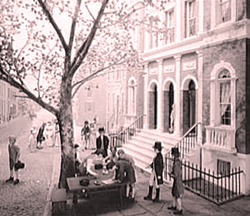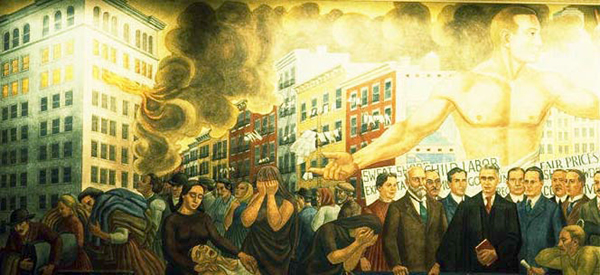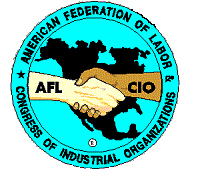Working in New York: A Timeline
BEGINNING TO 1843: TRADE
1625: Early Business
The Dutch West India Company’s trading post at the southern end of Manhattan is named New Amsterdam.
1670: Early Commerce
The royal governor of New York organizes the colony’s first merchants’ exchange where craftsmen, importers and merchants conduct business for an hour every week.
1691: Government Regulation
The city establishes rules governing the carting business, including fees, size of loads and who can own carts.
1768: Business Group
Twenty merchants organize the New York Chamber of Commerce in a meeting at Fraunces Tavern.
 1792: Trading Shares
1792: Trading Shares
The New York Stock Exchange has its beginnings as 21 brokers sign an agreement under a buttonwood tree on Wall Street. In the pact, they agree to rules of conduct and set commissions.
1835: Great Fire
Fires in the Wall Street area level much of the city’s financial district, so that banks and insurance companies cannot make payments. The Common Council, a precursor of City Council, only authorizes $6 million in loans. In the ensuring financial chaos, banks and insurance companies fail and prices rise sharply.
1844 TO 1945: RETAIL AND MANUFACTURING
 1877: Beginnings of the AFL
1877: Beginnings of the AFL
New York cigar maker Samuel Gompersreorganizes the Cigarmakers Union, setting up an international union and establishing dues to pay for strike funds and pensions. In 1886, Gompers will form the American Federation of Labor, which he will head for most of the following 40 years.
1899: Safer Factories
The New York State Legislature passes the Costello Anti-Sweatshop Act, which regulates work done in city tenements. It also passes measures to increase worker safety laws and limits working hours for women and children.
1900: The Union Label
The International Ladies’ Garment Workers Union, representing workers in Newark, Philadelphia and Baltimore as well as New York City, is founded on the Lower East Side.
1909: On the Picket Line
As 20,000 working women, members of Ladies Waist Makers Union Local 25, go out on strike, rich women’s suffragists join the young immigrant women to push for better pay and working conditions. The workers will return to their jobs after nine weeks, having won higher wages and a 52-hour work week.
1910: Help for the Hurt
The state legislature establishes a worker’s compensation system to insure workers who are injured on the jobs and to provide incentives for employers to improve job safety.
1911: Triangle Tragedy
A four-alarm fire sweeps through the Triangle Shirtwaist Factory on Washington Place, killing 146 people, most of them young women. There is no sprinkler system in the factory, fire department ladders are too short to reach the blaze, and the owners have locked all the exists to the factory to prevent theft, leading the workers to leap from the factory. The fire prompts new demands for safer conditions in factories, but the factory owners will be acquitted on al manslaughter charges related to the fire.

1911: Shorter Hours
The state legislature passes a law limiting the number of hours women can work per week in a factory to 54.
1913: Bank Regulation
President Woodrow Wilson signs a law establishing the Federal Reserve System to regulate U.S. banking and currency. It established 12 Federal Reserve Banks, including one in New York City.
 1916: Child Workers
1916: Child Workers
In an effort to control child labor, Congress passes the Keating-Owen Act, which bans interstate transportation of products made in factories, shops, canneries or mines employing children. In 1918 the Supreme Court will rule the act unconstitutional.
1925: A New Union
A. Phillip Randolph, publisher of the “Messenger,” a New York monthly on black politics and culture, organizes the Brotherhood of Sleeping Car Porters in Harlem.
1933: New York Woman
 President Franklin Roosevelt names Frances Perkinsof the Consumers League of New York as his labor secretary. The first woman Cabinet member ever, she will serve at a time when government involvement in labor issues increases dramatically. In the same year, Roosevelt established the National Labor Board to insure worker’s rights to collective bargaining. It will be chaired by New York Senator Robert F. Wagner.
President Franklin Roosevelt names Frances Perkinsof the Consumers League of New York as his labor secretary. The first woman Cabinet member ever, she will serve at a time when government involvement in labor issues increases dramatically. In the same year, Roosevelt established the National Labor Board to insure worker’s rights to collective bargaining. It will be chaired by New York Senator Robert F. Wagner.
1935: National Labor Law
Congress approves President Roosevelt’s plan to create a Social Security program to provide benefits to the retired and the unemployed. It would be financed by a payroll tax on current workers’ wages. Congress also passes the Wagner Act, introduced by Senator Robert Wagner of New York, guaranteeing workers the right to collective bargaining and establishing other rights for labor unions and their members.
1938: Regulating Work
Congress passes the Fair Labor Standards Act, putting limits on the length of the work week, requiring overtime pay and setting a minimum wage of 25 cents an hours for most workers. For the first time, federal law will set a minimum age for employment and limit the number of hours that children can work.
1945 TO TODAY: BUSINESS AND FINANCE
 1958: Unions for City Workers
1958: Unions for City Workers
Mayor Robert Wagner, son of the pro labor senator, signs an executive order giving municipal employees the right to collective bargaining with the city.
1964: Equal Rights
Congress passes the Civil Rights Act, which prohibits discrimination in employment based on race, color, religion, sex or national origin.
1967: Staying on the Job
Following several strikes by public employees, including a transit strike the year before, New York State passes the Taylor Act, which allows government employees in the state to form unions and negotiate contracts but bars most public employees from going out on strike.
1968: City Projects
The state legislature creates the Urban Development Corporation, a public authority to initiate, finance, build and manage projects in the state. Although in its early years, it will concentrate largely on housing, it will turn increasingly to aiding economic development projects, such as the South Street Seaport and the Marriott-Marquis Hotel.
 1970: Cleaning Up Factories
1970: Cleaning Up Factories
Congress passes the Occupational Safety and Health Act setting regulations for safety in the workplace and establishing an agency to enforce them.
1986: Special Districts
New York State establishes the Empire Zones program to attract companies to blighted areas throughout the state, including New York City, with lower taxes, worker-training programs and low-interest loans.
1993: Trade Agreement
Congress, with strong backing from President Bill Clinton, approves the North American Free Trade agreement, which establishes a free trade zone encompassing Mexico, Canada and the U.S. Proponents say it will create jobs and help consumers, while opponents say it will undercut wages for U.S. workers, encourage businesses to move jobs to Mexico and erode environmental and workplace safety protection.
 1997: New York Sweatshops.
1997: New York Sweatshops.
In the first such survey ever taken by the federal government, investigators find that 59 percent of a randomly selected sample of New York garment factories violate overtime laws and pay employees less than the minimum wage. Some of these factories provide merchandise for chain stores, such as Wal-Mart, Kmart and Nordstrom.
1999: Town/Gown
The New York State legislature and Governor George Pataki create the NYSTAR program to encourage the state’s research universities and institutions to invest in technologies that will create jobs in cutting edge industries.
2002: Enough to Live On
City Council passes a living wage bill raising the pay of 50,000 home health care attendants to $8.10 an hour with benefits (about 60 cents above the current average), or $9.60 an hour without benefits.
2002: Economic Boost
Congress passes The Job Creation and Worker Assistance Act of 2002 that extends the amount of time workers can receive unemployment benefits from 26 to 39 weeks and provides tax breaks for businesses to encourage them to expand and create more jobs.
2004: Minimum Wage Dispute
Over Governor George Pataki’s objections, the state legislature agrees to increase the minimum wage in the state to $7.15 an hour by 2007 (the federal minimum wage is $5.15 an hour).Â




